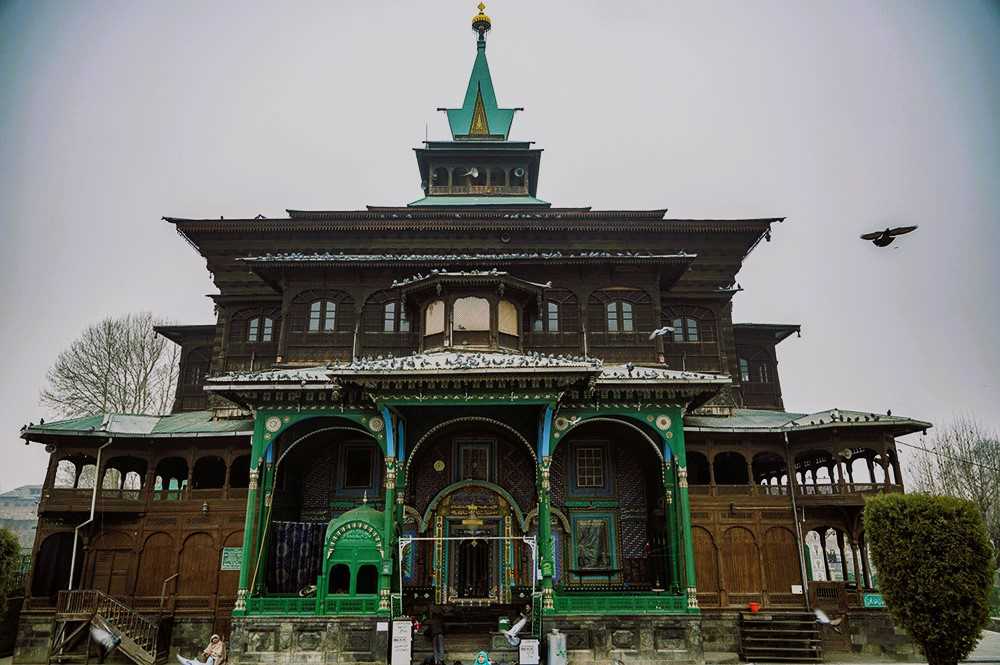
Nestled along the banks of the Jhelum River in the heart of Srinagar lies Khanqah-e-Moula, one of Kashmir's most revered and historically significant shrines. With its stunning wooden architecture, rich history, and spiritual ambiance, Khanqah-e-Moula stands as a testament to the region's cultural and religious heritage.
The Khanqah-e-Moula, also known as the Shrine of Shah-e-Hamadan, is dedicated to Mir Sayyid Ali Hamadani, a Persian Sufi saint who is credited with spreading Islam in Kashmir in the 14th century.
Born in Hamadan, Iran, in 1314, Shah-e-Hamadan traveled extensively before arriving in Kashmir, where he played a pivotal role in the spiritual and cultural transformation of the valley.
Constructed in 1395, the shrine is an architectural marvel, showcasing intricate wooden carvings, vibrant papier-mâché work, and beautifully painted interiors. The structure reflects the traditional Kashmiri style, with influences from Central Asian and Persian architecture. The serene courtyard, adorned with lush chinar trees, provides a tranquil setting for contemplation and prayer.
Visitors to Khanqah-e-Moula are greeted by the sight of its striking green and white façade, topped with a golden dome. As they step inside, the scent of burning incense and the soft murmur of prayers create an atmosphere of deep reverence. The walls of the shrine are adorned with verses from the Quran, and the wooden ceilings feature intricate floral and geometric patterns.
The spiritual significance of Khanqah-e-Moula extends beyond its architectural beauty. It serves as a hub for Sufi practices, attracting devotees from all over Kashmir and beyond. The shrine is particularly vibrant during the Urs, the annual commemoration of Shah-e-Hamadan’s death anniversary, when thousands of pilgrims gather to pay homage and seek blessings.
Khanqah-e-Moula also holds a special place in the cultural memory of Kashmir. It has been a center of learning, where scholars and poets have gathered to discuss religious, philosophical, and literary topics. The shrine's library houses rare manuscripts and texts, preserving the intellectual heritage of the region.
Local residents, like Mohammad Yousuf, a frequent visitor to the shrine, speak of the profound sense of peace and connection they feel at Khanqah-e-Moula. "This place is not just a shrine; it is a symbol of our history and spirituality. Whenever I come here, I feel a deep sense of solace and spiritual renewal," he says.
In recent years, efforts have been made to preserve and restore the shrine, ensuring that it continues to inspire future generations. Conservation projects have focused on maintaining the integrity of its wooden structure and intricate artwork, recognizing its status as a cultural and historical treasure.
Khanqah-e-Moula remains a beacon of faith and heritage in Srinagar, drawing people of all backgrounds to its sacred halls. Its timeless beauty and spiritual significance continue to resonate, making it a cherished landmark in the cultural landscape of Kashmir. As the city around it evolves, Khanqah-e-Moula stands as a testament to the enduring legacy of Shah-e-Hamadan and the rich history of the Kashmir Valley.
Nestled along the banks of the Jhelum River in the heart of Srinagar lies Khanqah-e-Moula, one of Kashmir's most revered and historically significant shrines. With its stunning wooden architecture, rich history, and spiritual ambiance, Khanqah-e-Moula stands as a testament to the region's cultural and religious heritage.
The Khanqah-e-Moula, also known as the Shrine of Shah-e-Hamadan, is dedicated to Mir Sayyid Ali Hamadani, a Persian Sufi saint who is credited with spreading Islam in Kashmir in the 14th century.
Born in Hamadan, Iran, in 1314, Shah-e-Hamadan traveled extensively before arriving in Kashmir, where he played a pivotal role in the spiritual and cultural transformation of the valley.
Constructed in 1395, the shrine is an architectural marvel, showcasing intricate wooden carvings, vibrant papier-mâché work, and beautifully painted interiors. The structure reflects the traditional Kashmiri style, with influences from Central Asian and Persian architecture. The serene courtyard, adorned with lush chinar trees, provides a tranquil setting for contemplation and prayer.
Visitors to Khanqah-e-Moula are greeted by the sight of its striking green and white façade, topped with a golden dome. As they step inside, the scent of burning incense and the soft murmur of prayers create an atmosphere of deep reverence. The walls of the shrine are adorned with verses from the Quran, and the wooden ceilings feature intricate floral and geometric patterns.
The spiritual significance of Khanqah-e-Moula extends beyond its architectural beauty. It serves as a hub for Sufi practices, attracting devotees from all over Kashmir and beyond. The shrine is particularly vibrant during the Urs, the annual commemoration of Shah-e-Hamadan’s death anniversary, when thousands of pilgrims gather to pay homage and seek blessings.
Khanqah-e-Moula also holds a special place in the cultural memory of Kashmir. It has been a center of learning, where scholars and poets have gathered to discuss religious, philosophical, and literary topics. The shrine's library houses rare manuscripts and texts, preserving the intellectual heritage of the region.
Local residents, like Mohammad Yousuf, a frequent visitor to the shrine, speak of the profound sense of peace and connection they feel at Khanqah-e-Moula. "This place is not just a shrine; it is a symbol of our history and spirituality. Whenever I come here, I feel a deep sense of solace and spiritual renewal," he says.
In recent years, efforts have been made to preserve and restore the shrine, ensuring that it continues to inspire future generations. Conservation projects have focused on maintaining the integrity of its wooden structure and intricate artwork, recognizing its status as a cultural and historical treasure.
Khanqah-e-Moula remains a beacon of faith and heritage in Srinagar, drawing people of all backgrounds to its sacred halls. Its timeless beauty and spiritual significance continue to resonate, making it a cherished landmark in the cultural landscape of Kashmir. As the city around it evolves, Khanqah-e-Moula stands as a testament to the enduring legacy of Shah-e-Hamadan and the rich history of the Kashmir Valley.
© Copyright 2023 brighterkashmir.com All Rights Reserved. Quantum Technologies